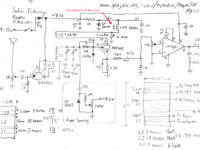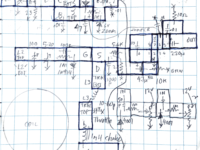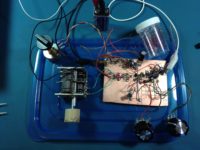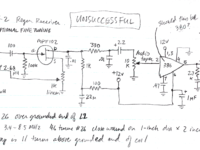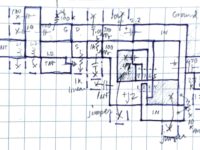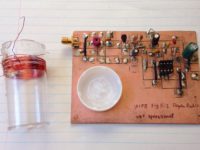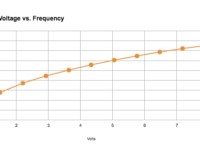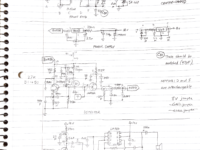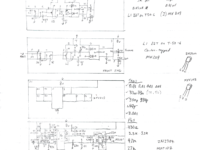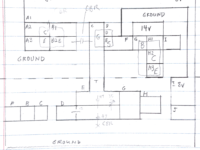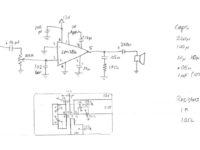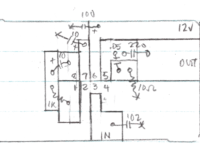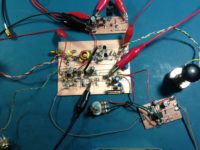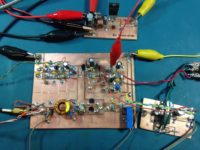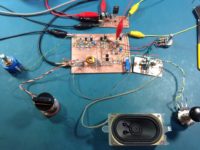Hackaday recently had a post called “Everyone Should Build at Least One Regenerative Receiver“. These are relatively simple radios to build and they can receive any type of modulation, from AM to Single Sideband, to FM. Although the regen is one of the oldest receiver designs, it’s still widely used in garage door openers, walkie-talkies and wireless “internet of things” devices.
Over the past year or so, I’ve taken the “at least one” part of the title literally. Last year I built several regens, some successful, some not:
John Fuhring’s Regen Receiver – April–October 2016
John Fuhring has an extensive and entertaining account of his attempts at building a Charles Kitchin “Scout Beginner’s Receiver” regen kit. Because he was so forthcoming about his ups and downs in his regen saga, I decided that I’d try following in his footsteps for my first scratch-built regen.
My plan was to use a variation of the manhattan style of component placement, by cutting-out spaces from a grid of squares on the copper surface of the pc, as I did with the oscillator/amplifier project described in the previous post.
The radio tuned from 6.4 – 8.0 MHz. Although successful, it had poor selectivity (radio stations on top of each other), it had a hum from the power supply that was alleviated by substituting a battery, and the LM386 audio amplifier was susceptible to troublesome ‘motorboating’. I disassembled this radio in December 2016.
Ray Ring’s High Performance Regenerative Radio – October 2016
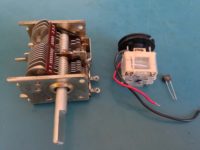
What attracted me to this circuit were the words “high performance” (although as I’ve discovered, a large percentage of designs promote themselves this way, but in my experience “high performance” may not fully apply) and the fact that the tuning mechanism can be easily adapted to employ a solid state “varactor” rather than the old-school and increasingly hard to find “air variable capacitor”. I’ve managed to collect a few air variables over the past couple of years. They have good selectivity but the dial travel is only about 180°, so they are difficult to tune unless you build a string pulley dial (used in most table radios back in the day) or use a vernier reduction gear mechanism (expensive and also hard to find).
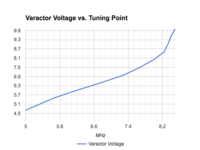
There are two alternatives to the air variable: the first is the “polyvaricon”, which is used in most clock radios and portable transistor radios. It doesn’t have as good selectivity as an air variable, and it’s also difficult to tune. The other is the “varactor”: this is a special diode which changes its capacitance based on the amount of voltage that is used to bias it. A varactor is tuned with a potentiometer—standard pots have a travel of around 270°, which is better than variable capacitors—and you can also use an inexpensive ten turn pot which can tune into even the narrowest of signals.
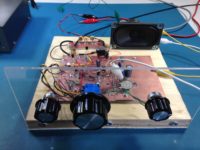
My initial build of Ring’s circuit used a polyvaricon, then two in parallel but the result was unstable. I tried different varactors. I also struggled with local FM broadcast interference: to combat the breakthrough, I built a 7-pole Butterworth low pass filter. I discovered that the hookup wire in the RF part of the radio was also picking up FM broadcast harmonics, so I replaced the wires to and from the low pass filter with RG174 coax, and that solved the problem. As you can see, I used the manhattan style construction technique.
After much experimentation, I settled on a BB112 varactor which the data sheet says goes from 470pF at 1v down to 20pF at 8v. For reasons that I can’t remember, I set the voltage/tuning range of the radio from 4.75 – 8.5v, which gave me an effective tuning range at one point from 5.0 – 8.2 MHz. I then changed from a small commercial wirewound 11.5 µH inductor to a 5µH hand-wound T50-6 toroid inductor. The radio now tunes from 7.8 – 13.2 MHz.
W1FB Doug DeMaw’s Two-stage Regen from his Design Notebook – Unsuccessful
From November 2016, an even simpler design: this one came from the “W1FB Design Notebook”, figure 5-2. The circuit uses a customary Armstrong tapped coil with one Field Effect Transistor (effectively replacing Armstrong’s original vacuum tube). For this build, I used the same technique as the John Fuhring regen above, rather than using copper islands/manhattan construction for the previous radio.
Unfortunately, I could not get the radio to oscillate. Looking back on it, there may have been several reasons for this:
- the coil was too close to the copper groundplane
- there may have been some solder resin remaining on the board; resin can conduct
- it’s possible that I got the windings of the coil backwards
WBR Regen Receivers
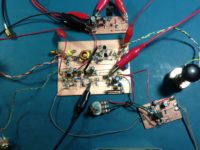
In late December, I built a wheatstone bridge regen using AA7EE’s circuit. Although it did work, performance was disappointing.
I disassembled it shortly thereafter.
The WBR idea remained interesting to me. I found an article from QST August 2001 called “The WBR Receiver” by Dan Wissell, N1BYT. I used his design for my next radio. My notes:
- the pot turn shafts are slightly wider than the knobs that I have. I experimented by using a cutting disk to cut a slot down the middle. Heats the pot up, but seems to do no lasting damage. Also tried just grinding down around the circumference, which seems a better solution.
- took one turn off each end of the main inductor.
- the trimpot controlling the lower tuning voltage limit was not wired in properly. Adjusted to bottom out around 1 volt.
- radio now tunes from 9.450 – 10.070 MHz. Have not yet heard WWV.
- completed breadboarding: mounted boards and pots, replaced connecting wires with coax where desirable
- reception seems stronger: however, AM and SSB signals seem to have a tremolo
- radio now tunes from 9.410 – 10.010 MHz. Have heard WWV!
Jan 3, 2017
- added VE7BPO AF Preamp for WBR Regen circuit to improve audio level. Low level signals now audible.
